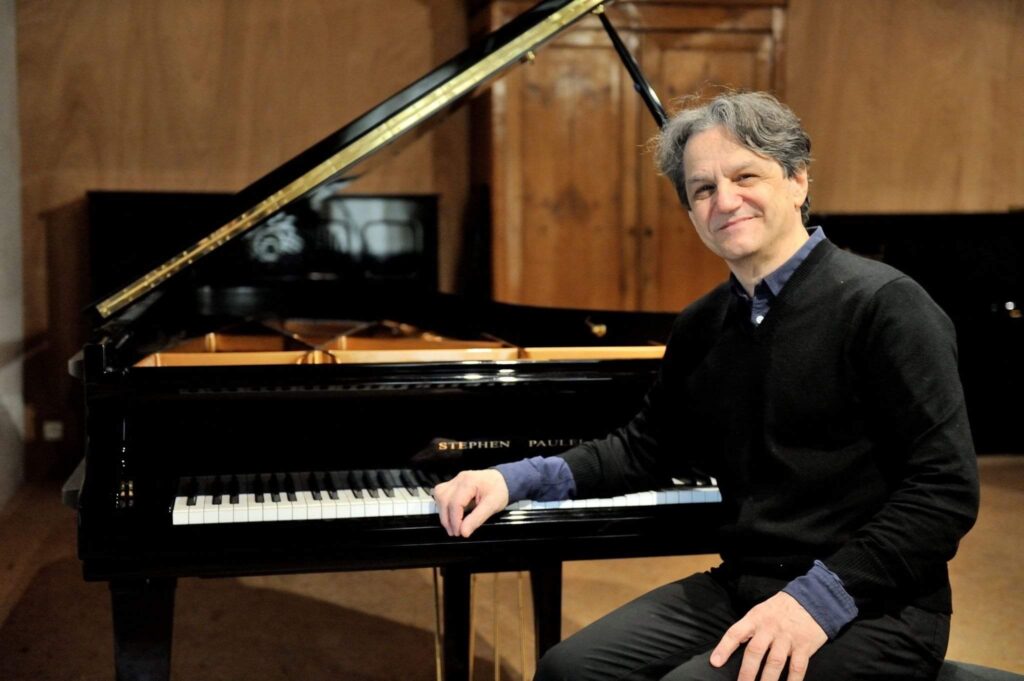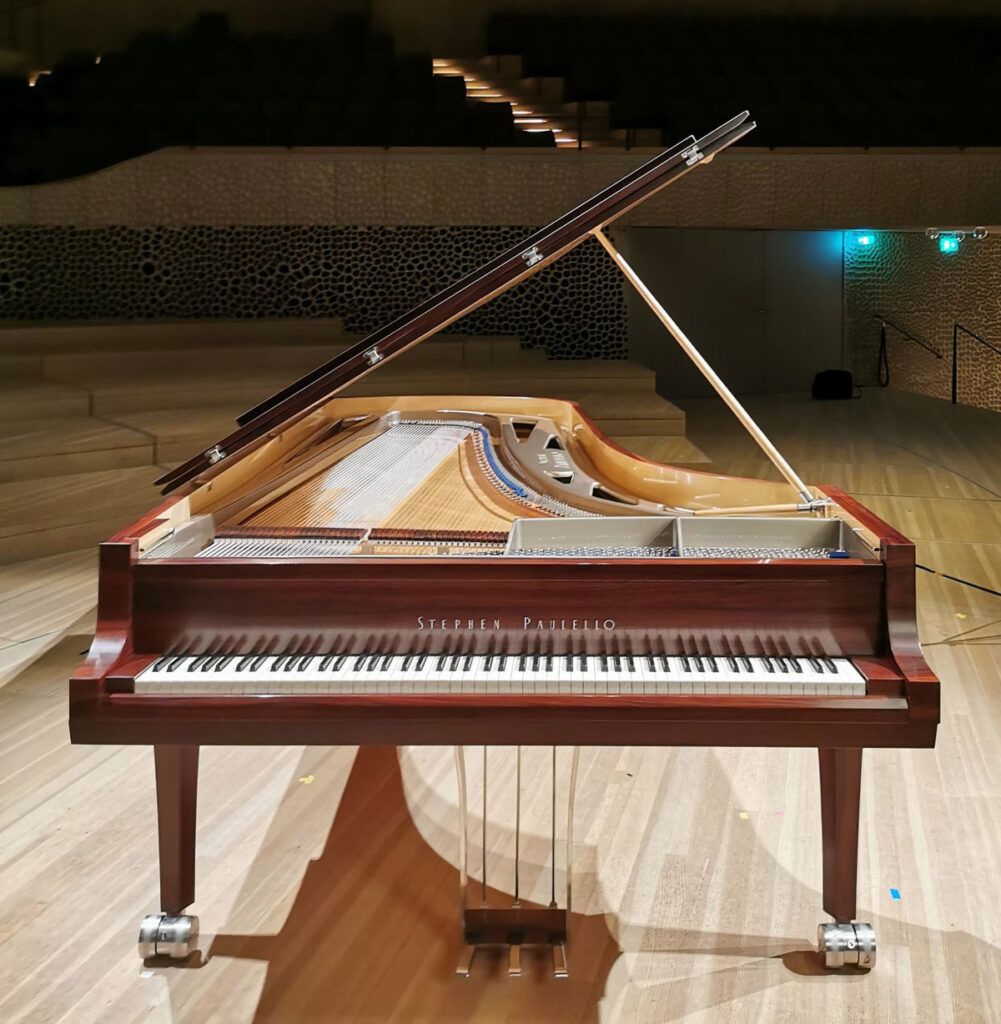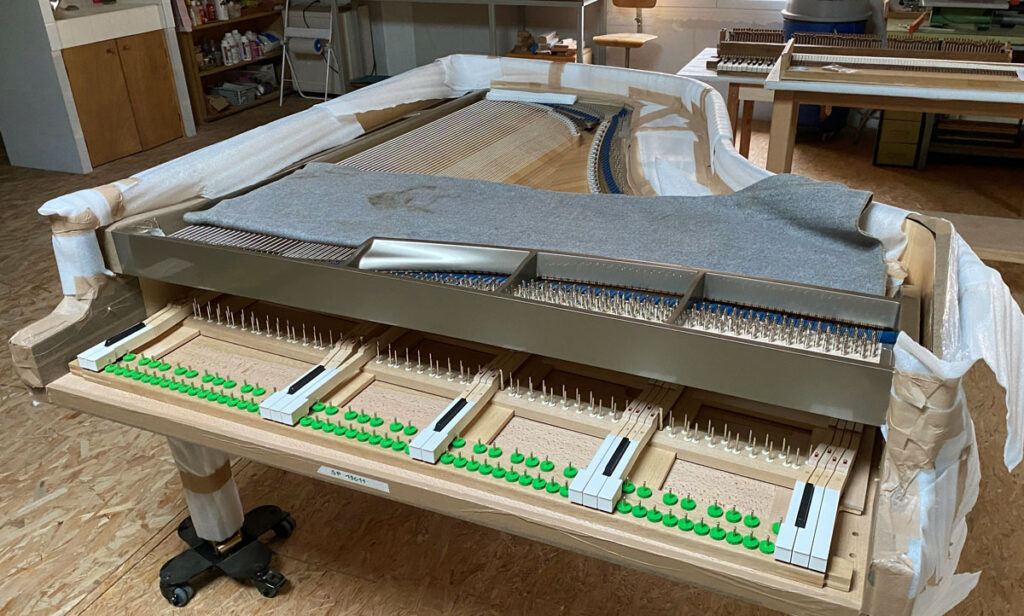State Of the Art Innovations – The 102 keys Stephen Paulello Grand Piano
For more than 30 years, Stephen Paulello has systematically studied all the components of the piano, including the instruments of previous eras. But as a pianist dreaming of more complex and expressive sonorities, he doesn’t content himself with a cult of the past. Instead, he has often used his findings to challenge generally accepted ideas. His unique grand pianos are constructed to order in his workshop-laboratory 100 kms south of Paris, where there is also a recording studio. Piano Street’s Patrick Jovell has interviewed Stephen Paulello about his visions and achievements.

Piano Street: Many a professional and famous musician have spoken of you, and your instruments are frequently used for recordings. Vienna has ordered one Opus 102 instrument from you. What can you tell us about this ”sounding” part of the Stephen Paulello, for those who cannot come and visit your workshop in Villethierry outside Paris?
Stephen Paulello: An Opus 102 was sold to a Viennese dealer who would like to sell it to a great concert hall or recording studio in Vienna. The Opus 102 has a great equality of sound in all registers, a great power, a great dynamic, an infinite variety of colours, great clarity, very deep bass, very bright treble, an exceptional sustain that allows a true legato. However, it is difficult to describe the sound of a piano in words. It is better to come to us and taste this instrument. This experience usually does not leave one indifferent.

PS: Instrument makers are artists with an additional dimension. They do not only know what they are looking for sound wise, but they also know how to achieve it in terms of construction. All artists are driven by an initial source or inspiration. Which was your trigger in wanting to create your own piano brand?
SP: I made my first concert grand piano (2m87) thirty years ago. At this time, I was a concert pianist and piano teacher and there was no question of creating a brand but of making an instrument that would allow me to do what I could not do with usual commercial instruments. I used to play this instrument for my concerts and recordings and often lent it to some of my friends. In 1996, I developed a new way of stringing pianos – “hybrid stringing” – by creating my own plain steel wires, which are now marketed all over the world. In 2004, I decided to give up my career as a pianist and piano teacher in order to devote myself to the manufacture in very small series, extremely meticulous, of non-standard instruments. I wanted to rethink piano building in all its details.
PS: The construction of your grand instrument with 102 notes stresses the use and importance of parallel oblique strings and a barless frame. What can you tell us about this specific relationship including the extra 4th?
SP: Our three piano models (SP190, SP230, SP300) have 102 keys: 9 extra notes in the low register (a sixth) and 5 extra notes (a fourth) in the high register. Several reasons led me to add notes to the usual 88-note keyboard:
-
The evolution of piano making ceased when the range of the keyboard stopped expanding. Extending again the keyboard, is a symbol that piano history moves ahead again
The additional notes, especially in the low register, enriches the whole piano sound.
Today’s composers have at their disposal an instrument that broadens their scope. Until today, more than 10 works were written especially for Opus 102, including extra-notes.
Regarding the barless frame, the aim was to avoid the change of sound quality that is usually noticeable around each frame bar. Removing them brings additional homogeneity and equality to the whole. Parallel strings significantly increase the legibility, intelligibility and articulation of musical phrases especially in the lower-middle and bass ranges. I made them oblique so as to allow as long speaking lengths as those of a cross stringed instrument.

PS: Many a discussion on piano construction and re-thinking comes down to the wooden case – quality and best sound design – as well as the strings. Which are your thoughts on this?
SP: As I mentioned earlier, I have developed another way of stringing pianos by producing and marketing SP strings. The plain strings of our pianos are covered with an electrolytic nickel coating. The bass strings are spun with nickel-plated soft iron and nickel-plated bronze. The soundboard, the bridge, the striking line, the action, the keyboard deserve according to me a priority attention before taking care of the wooden case and external finish, even if we worked on it as well.
One recent recording made in Studio Stephen Paulello is an album of Bach Toccatas played by Laurent Cabasso, who says of the instrument:
– The first time I tried Stephen Paulello’s Opus 102, I was immediately struck by three things, three qualities which we rarely encounter together in a piano: an exceptional length of sound, perfect clarity of the registers due to its parallel strings, and a clear, bright tone… A tenacious doubt often plagued me whenever I played Bach on the piano. This sensation is radically different on Stephen Paulello’s instrument, which brings a remarkable clarity to the polyphony and the tone, so essential to this music.
Comments
102 keys? What a madman!! I want to try one. I have played on I believe it was a Boesendorfer with extra keys in the lower register. Honestly, going below G or so the lower keys were kind of useless beccause it sounds like a dark mud with barely discernable pitch. But that extra A flat and G are great.
As a 50 year professional, I heartily agree with the PAULELLO concept. If I win the Lottery, I will order one.
…..if the piano sound isn’t too bright
The stringing pattern is, as I see it, a step back in history, but a frame without bars is something new and revolutionary.. But, are those “improvements” the cause of the unique sound? Can a normal ear notice these refinements? Each piano has its typical sound as a result of many factors – construction, tuning, intonation etc. Then the pianist can affect the volume of tones, but not the colour of a single note. The performance of pianists sound differently, because pianists do no hit single keys, but they play music, interprete a work, use the sustain pedal differently etc.
Stephen Paulello is a pioneer in the further development of the piano. It is because of visionaries such as the above-named that new possibilities are born. I like the idea of 102 key instrument because it gives greater scope and range. He is really “pushing the boat out” with his concepts and I admire his bravery in seeking new ways of doing things.
Hi Stephen, I’m part of an International group PASK which is requesting manufacturers to make pianos with narrower keys for those of us who don’t have Rachmaninoff hands. Would this be an option for your pianos? Straight stringing does make narrower keys more possible .
Looking forward to hearing your thoughts.
Kind regards
Erica
http://www.paskpiano.org
The above claim that a pianist cannot influence the color of a single note is falsehood. Depending on how you strike the instrument you will get different amount of key noise interfering with the string vibration and the overtones, especially when you add pedal. There is a noticeable difference between “the long vibration” and the strangled sound from somebody who pounds with all their might but still cannot be heard over the orchestra.
Broadwood were making barless grands a century ago! I own one and it has a lovely tone.
I’m wondering about the “extra” keys being white. These extra keys can be disorienting to pianists used to 88 keys, so perhaps a darker color would be more appropriate? I’ll let Oscar Peterson explain. https://youtu.be/q8k4G_ihjnA?si=zBIziYmYELQx5Gem&t=107
If the Opus 102 has seven extra keys at the top and bottom of the keyboard, is there any music written in the past few centuries that calls for the use of those keys? I am trying to figure out what they add in terms of the standard piano repertoire?